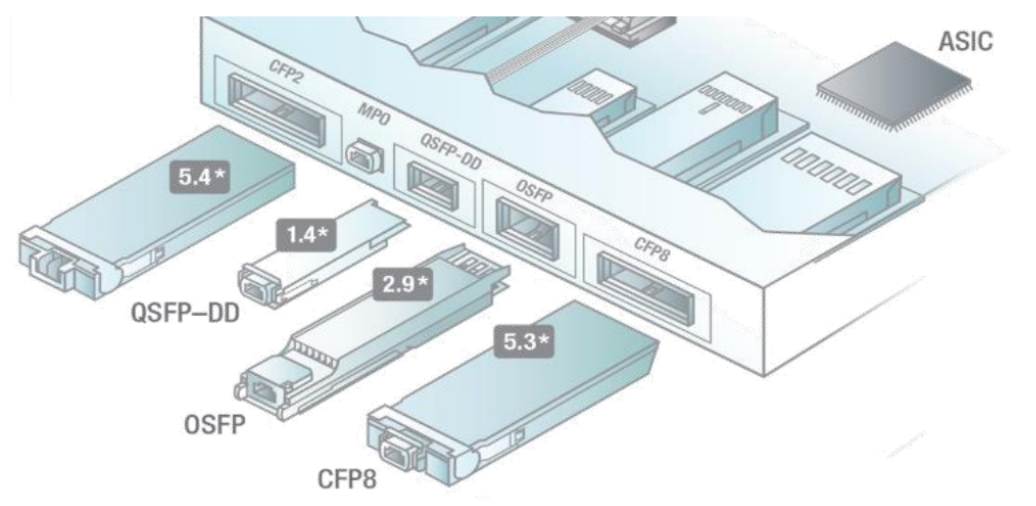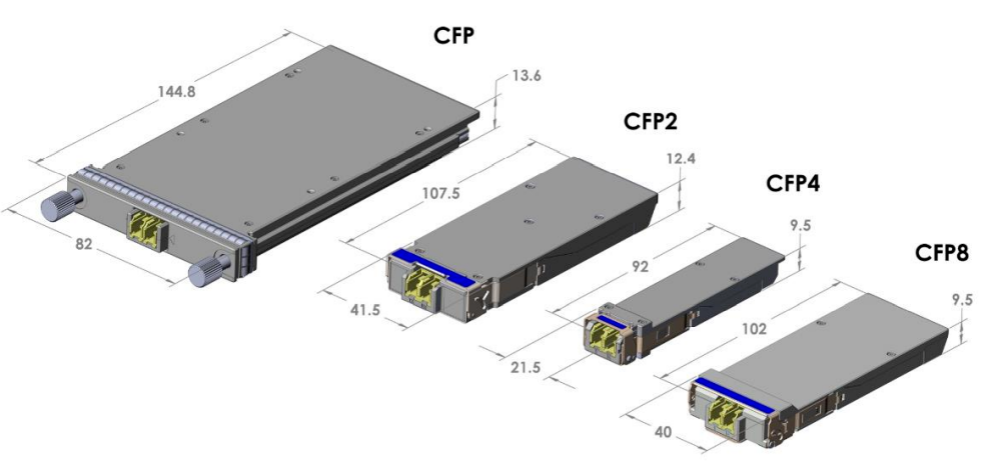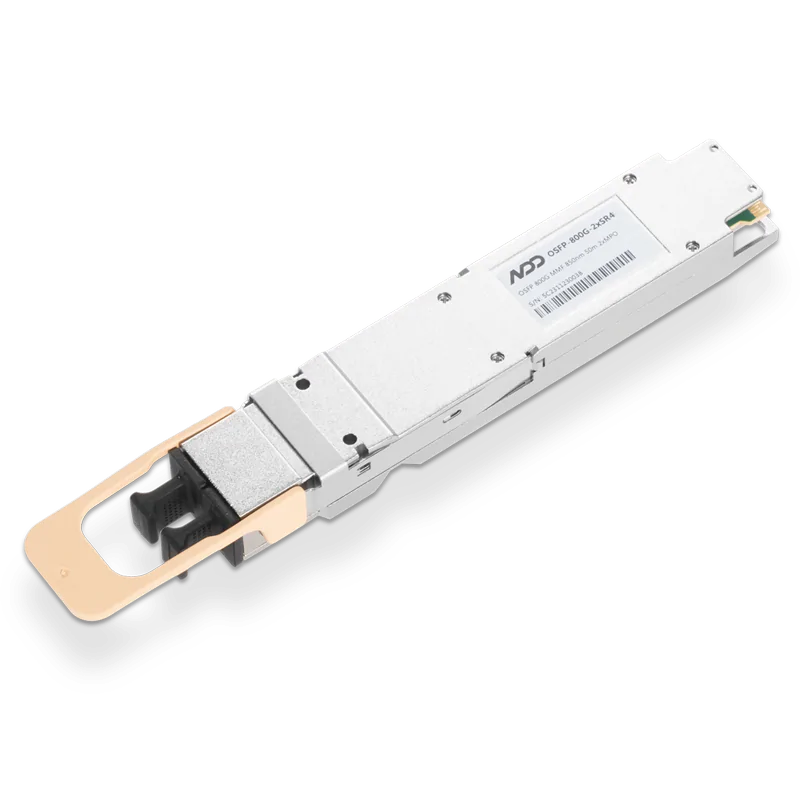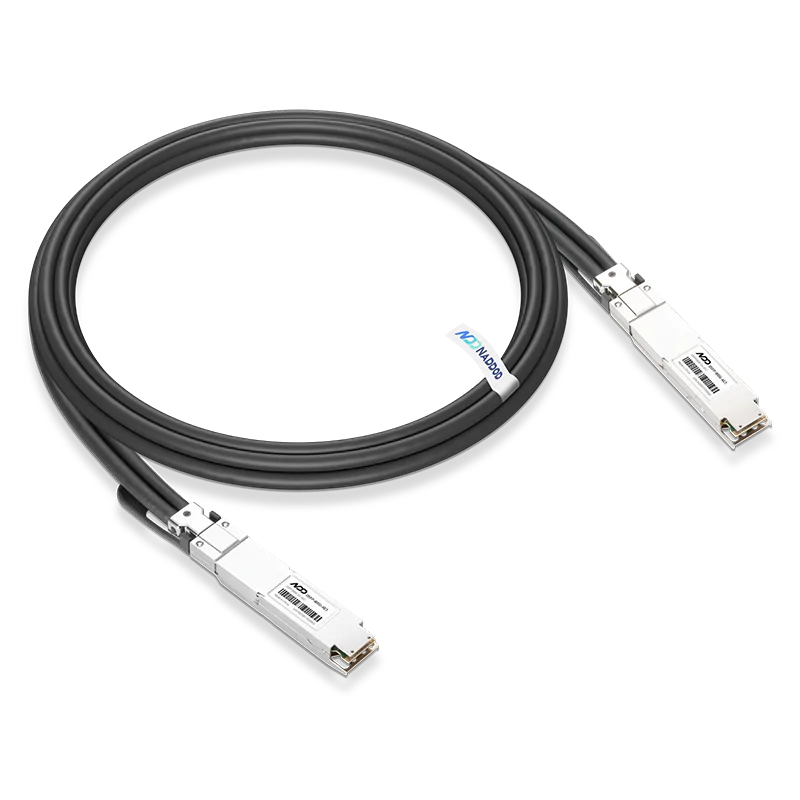The 400G optical transceiver refers to an optical module product with a transmission rate of up to 400Gbps, which is an advanced product in the field of high-speed transmission and is widely used in high-performance data centers, communication networks, large-scale computing, cloud computing, and other fields.
What is a 400G optical module?
The 400G optical module is mainly used for optoelectronic conversion, where electrical signals are converted into optical signals at the transmitting end and transmitted through optical fibers. At the receiving end, the optical signals are converted back into electrical signals. The main function of the 400G optical module is to increase data throughput and maximize bandwidth and port density in data centers. Its future trend is to achieve wide gain, low noise, miniaturization, and integration performance, to meet the application requirements of next-generation wireless networks and ultra-large-scale data center communications.
Types of 400G optical modules based on different applications
According to the different applications of optical modules, 400G optical modules can be divided into client-side optical modules and line-side optical modules.
400G optical modules for client-side use.
Usually, client-side optical modules are used for link connections between metropolitan area networks and backbone networks. Compared with line-side optical modules, the transmission distance of client-side optical modules is shorter, generally within 50 meters to 10 kilometers, and transmission can be achieved through optical fibers without the need for DWDM equipment. Earlier, the IEEE and MSA working groups issued relevant standard protocols for different 400G interfaces. Among them, the IEEE802.3bs standard defined that 400G client-side interface technology will use PAM4 modulation technology.
400G optical modules for line-side applications
Different from customer-side optical modules, line-side optical modules are generally used in conjunction with DWDM and can transmit signals up to 80 kilometers or even further. Earlier, OIF developed a flexible 400G coherent DWDM transmission protocol framework for long-haul, metropolitan, and data center interconnects, which is expected to be used for 400G line-side transmission. Compared with PAM4 technology, the signal processing capability of 400G line-side optical modules using coherent technology is much stronger, and it does not require a lot of DSP and power.
Types of 400G optical modules based on different packages
There are five standard types of 400G optical modules: QSFP-DD、OSFP、COBO、CDFP and CFP8.

QSFP-DD
QSFP-DD, Q refers to “Quad”, which means four optical signals, DD refers to “Double Density”, two QSFP-56 are paralleled to form a 2*200G 400G signal. The 400G QSFP-DD electrical interface adopts 8 channels, and the rate of each channel is up to 50Gb/s (PAM4 modulation).
QSFP-DD enables up to 14.4Tb/s aggregate bandwidth in a single switch slot. By quadrupling aggregation switch bandwidth at the same port density, QSFP-DD can support the continued growth of network bandwidth demands and data center traffic.
QSFP-DD is backward compatible with QSFP+/QSFP28. Systems designed using QSFP-DD modules are backward compatible and support existing QSFP+/QSFP28 modules, providing flexibility for end users and system designers.
QSFP-DD is better in size, power consumption and backward compatibility, and 400G switch devices generally use QSFP-DD ports, so QSFP-DD has become the most promising 400G standard at present, and it is also the technology with the most extensive deployment of global manufacturers standard.
OSFP
O in OSFP refers to “Octal”, which means octal, mainly through 8*50G to realize the 400G solution. Due to the built-in heat sink, this solution has greater advantages in terms of heat dissipation performance than other solutions, but has certain disadvantages in power consumption, volume and compatibility. OSFP is currently mainly promoted by Google. Since Google accounts for a high proportion of demand for datacom high-speed optical modules, it may occupy a large market space in the future.
COBO
COBO refers to “Consortium for On-Board Optics”. The difference between this solution and other traditional solutions is that the optical module is placed on the PCB board, which is not limited by the interface density of the front panel, and can use the powerful radiator link between the PCB boards cooling problem. There may be a certain application space in the future.
CDFP
CDFP is the first 400G optical module standard formulated. CDFP was originally designed as a 16/25G solution, which mainly meets the needs of short-to-medium distance application scenarios of 2km and below. Too many channels greatly limit the reduction of 400G CDFP optical module in terms of volume, power consumption and laser cost. And due to the gradual maturity of the PAM4-based 50G electrical port rate technology, the NRZ-based 16-channel CDFP standard has gradually withdrawn from the mainstream standard sequence.
CFP8
The CFP8 optical module standard is a high-speed evolution version based on 100G CFP/CFP2/CFP4, and adopts 1625G or 850G PAM4 (mainly 1625G solution) to realize 400G deployment. Because the number of channels of its mainstream 1625G solution is still large, it has similar disadvantages to CDFP in terms of volume, power consumption and laser cost, but it has a greater advantage in the maturity of the industry chain. CFP8 is mainly used in the telecom backhaul market.

Among the above-mentioned packaging types, OSFP, QSFP-DD, and CFP8 are three packaging types that are highly regarded in the 400G optical module market. The specific differences between these three packaging types are shown in the following table
| OSFP | QSFP-DD | CFP8 | |
|---|---|---|---|
| Application scenarios | Data center, telecommunication | Data center | Telecommunication |
| Size | 22.58×107.8×13mm | 18.35×89.4×8.5mm | 40×102×9.5mm |
| Maximum power consumption | 15W | 12W | 24W |
| Backward compatibility | Can be achieved by converting optical modules | Supported | Not supported |
| Electrical signal(Gbps) | 8×50G | 8×50G | 8×50G |
| Switch port density(1RU) | 36 | 36 | 16 |
| Fiber type | Single-mode and multi-mode | Single-mode and multi-mode | Single-mode and multi-mode |
| Hot-swappable | Supported | Supported | Supported |
| Thermal management | Direct | Indirect | Indirect |
| Support for 800G | Supported | Not supported | Not supported |
As shown in the table above, the biggest difference between CFP8 packaging and OSFP and QSFP-DD packaging is that its density is significantly lower. The biggest difference between OSFP packaging and CFP8 and QSFP-DD packaging is that it can meet the 800G Ethernet standard. The biggest difference between QSFP-DD packaging and CFP8 and OSFP packaging is its high density, small size, and backward compatibility (supporting QSFP28), making network upgrades to 400G more convenient.
NADDOD 400G Optical Module Solution
NADDOD focuses on the optical network market and is a leading provider of optical network solutions. The company has the industry’s first-class R & D and production strength, and continues to provide high-quality products and services to the market. NADDOD takes root in the industry and goes deep into the industry application scenarios for solution design and innovation. It provides 1G, 8G, 10G, 16G, 25G, 32G, 40G, 100G, 200G, 400G optical modules and network device solutions, which are widely used in cloud computing centers , data center, enterprise network, 5G wireless network and telecommunication transmission and other fields, and has accumulated rich successful cases in industries such as finance, electric energy, public safety, medical and health care, Internet, operators, media, and education.
Related Resources:
400G Data Center Network Solution Using Switch, SmartNIC and Optical Transceivers
Typical Solutions for 400G Data Center
Typical Connection Solutions of 400G Optical Transceivers and Cables
The Next Station of Data Center Networks—200G vs 400G
400G Optical Module Application Scenarios

 800GBASE-2xSR4 OSFP PAM4 850nm 50m MMF Module
800GBASE-2xSR4 OSFP PAM4 850nm 50m MMF Module- 1The New Era of 800G Optical Transceiver
- 2400G Data Center Network Solution Using Switch, SmartNIC and Optical Transceivers
- 3Typical Solutions for 400G Data Center
- 4NADDOD 1.6T XDR Infiniband Module: Proven Compatibility with NVIDIA Quantum-X800 Switch
- 5Vera Rubin Superchip - Transformative Force in Accelerated AI Compute


































